Myelin and collapsin-1 induce motor neuron growth cone collapse through different pathways: inhibition of collapse by opposing mutants of rac1
- PMID: 10066250
- PMCID: PMC6782563
- DOI: 10.1523/JNEUROSCI.19-06-01965.1999
Myelin and collapsin-1 induce motor neuron growth cone collapse through different pathways: inhibition of collapse by opposing mutants of rac1
Abstract
Precise growth cone guidance is the consequence of a continuous reorganization of actin filament structures within filopodia and lamellipodia in response to inhibitory and promoting cues. The small GTPases rac1, cdc42, and rhoA are critical for regulating distinct actin structures in non-neuronal cells and presumably in growth cones. Collapse, a retraction of filopodia and lamellipodia, is a typical growth cone behavior on contact with inhibitory cues and is associated with depolymerization and redistribution of actin filaments. We examined whether small GTPases mediate the inhibitory properties of CNS myelin or collapsin-1, a soluble semaphorin, in chick embryonic motor neuron cultures. As demonstrated for collapsin-1, CNS myelin-evoked growth cone collapse was accompanied by a reduction of rhodamine-phalloidin staining most prominent in the growth cone periphery, suggesting actin filament disassembly. Specific mutants of small GTPases were capable of desensitizing growth cones to CNS myelin or collapsin-1. Adenoviral-mediated expression of constitutively active rac1 or rhoA abolished CNS myelin-induced collapse and allowed remarkable neurite extension on a CNS myelin substrate. In contrast, expression of dominant negative rac1 or cdc42 negated collapsin-1-induced growth cone collapse and promoted neurite outgrowth on a collapsin-1 substrate. These findings suggest that small GTPases can modulate the signaling pathways of inhibitory stimuli and, consequently, allow the manipulation of growth cone behavior. However, the fact that opposite mutants of rac1 were effective against different inhibitory stimuli speaks against a universal signaling pathway underlying growth cone collapse.
Figures

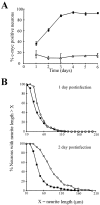
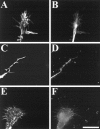
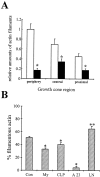
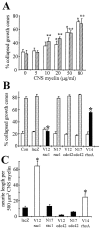

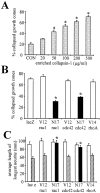

References
-
- Adamson P, Marshall CJ, Hall A, Tilbrook PA. Posttranslational modification of p21 rho proteins. J Biol Chem. 1992;267:20033–20038. - PubMed
-
- Arber S, Barbayannis FA, Hanser H, Schneider C, Stanyon CA, Bernard O, Caroni P. Regulation of actin dynamics through phosphorylation of cofilin by LIM-kinase. Nature. 1998;393:805–809. - PubMed
-
- Bantdlow CE, Schmidt MF, Hassinger TD, Schwab ME, Kater SB. Role of intracellular calcium in NI-35 evoked collapse of neuronal growth cones. Science. 1993;259:80–83. - PubMed
-
- Becker TC, Noel RJ, Coats WS, Gomez-Foix AM, Alam T, Gerard RD, Newgrad CB. Use of recombinant adenovirus for metabolic engineering of mammalian cells. Methods Cell Biol. 1994;43:161–189. - PubMed
Publication types
MeSH terms
Substances
Grants and funding
LinkOut - more resources
Full Text Sources
Other Literature Sources
Research Materials
Miscellaneous
